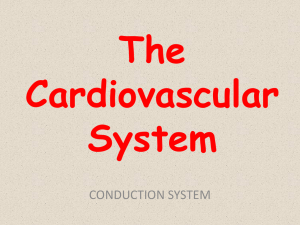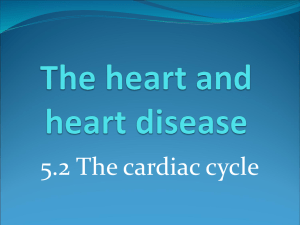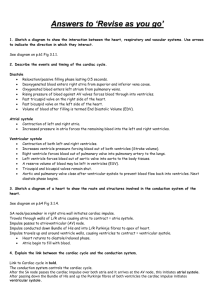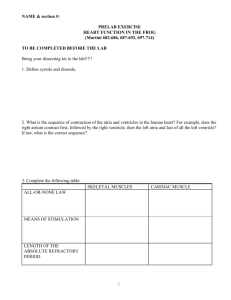Cardiac Output and Exercise
advertisement
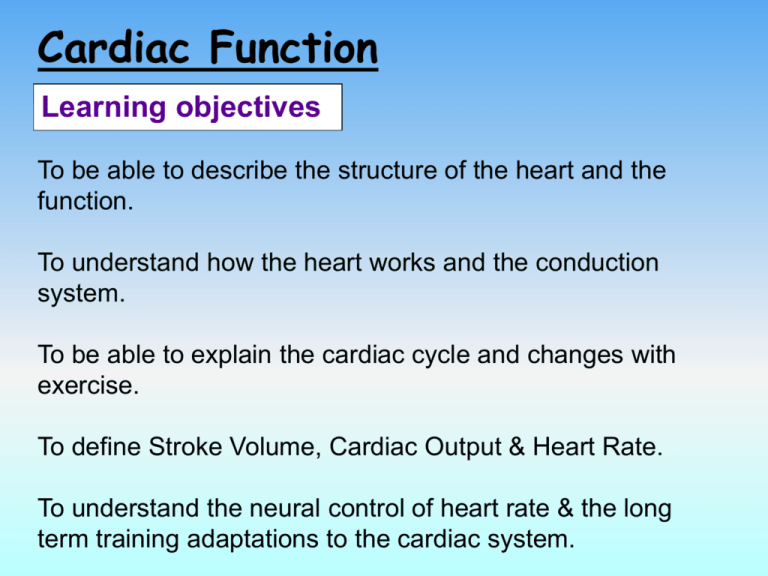
Cardiac Function Learning objectives To be able to describe the structure of the heart and the function. To understand how the heart works and the conduction system. To be able to explain the cardiac cycle and changes with exercise. To define Stroke Volume, Cardiac Output & Heart Rate. To understand the neural control of heart rate & the long term training adaptations to the cardiac system. Cardiac Function What does my heart do? Although your heart is only about the size of your closed fist, this small muscle is able to pump approximately 5 to 6 litres (about 1.5 gallons) of blood per minute, even when you are at rest! Structure of the Heart The heart is a muscular pump that is divided into 4 chambers. The two top chambers are called atria, and the two lower chambers are called ventricles. The two types of chambers perform different functions: The atria collect the blood that enters the heart and push it to the ventricles. While the ventricles push blood out of the heart and into the arteries to go to the rest of the body Vessels of the heart The right atrium of the heart receives deoxygenated blood from two major veins: The superior vena cava and the inferior vena cava. The pulmonary artery carries deoxygenated blood from the right ventricle to the lungs. The pulmonary vein delivers oxygenated blood from the lungs to the left atrium. Vessels of the heart The aorta carries oxygenated blood from the left ventricle to the body For the heart to work effectively, it requires a good blood supply. This is provided by the coronary artery, which carries oxygenated blood. Deoxygenated blood is removed by the veins of the heart into the right atrium through the coronary sinus. Heart Valves Your heart valves act as gates that allow blood to pass between heart chambers or from heart chambers to their associated blood vessels. They include the tricuspid, pulmonary, bicuspid (or mitral), and aortic valves. How the Heart Works – Conduction System The heart works by producing impulses which spread and innervate the specialised muscle fibres. The heart produces its own impulses (myogenic), and it is the conduction system of the heart which spreads the impulses and enables the heart to contract. CLICK TO WATCH A VIDEO CLIP Conduction System The electrical impulse begins at the pacemaker: a mass of cardiac cells known as the sino-atrial node (S.A. node). As the impulse is emitted, it spreads to adjacent interconnecting fibres of the atrium, which causes the atria to contract. Conduction System It then passes to another specialised mass of cells called the atrioventricular node (A.V. node). The A.V. node acts as a distributor and passes the action potential to the Bundle of His, Conduction System This action potential filters to the branching Purkinje fibres, spread the excitation throughout the ventricles. There is a delay of about 0.1 second from the time when the A.V. node receives stimulation, to when it distributes action potential through the ventricles. Conduction System The relationship between the electrical activity of the heart and the cardiac cycle can be shown in an electrocardiogram (ECG) Conduction System - Summary 1) 2) 3) 4) 5) 6) Heart generates own electrical impulses, At the sino-atrial node (pacemaker), Impulse spreads through cardiac tissue in the atria, This causes contraction of the atria, The impulse carries on to Atrio-ventricular node, The action potential moves into Bundle of His and spreads throughout the Purkinje fibres causing the ventricle to contract. The Cardiac Cycle This refers to the process of cardiac contraction and blood transportation through the heart. The heart has dual purpose, and the cardiac cycle explains the sequence of events that takes place during one complete heartbeat. Each cycle takes approximately 0.8 seconds and occurs on average 72 times per minute. The Cardiac Cycle The filling of the heart and subsequent emptying follows a particular sequence. There are four stages to each heart beat: 1) 2) 3) 4) Atrial diastole Ventricular diastole Atrial systole Ventricular systole Important points to note Diastole The heart filling with blood. ----------------The heart is relaxing Systole The heart emptying. ------------------The heart contracts 1. Atrial diastole This is the 1st stage of the cardiac cycle. The upper chamber of the heart are filled with blood returning from: • The body via the vena cava to the right atrium. • The lungs via the pulmonary vein to the left atrium. At this time the atrio-ventricular valves are shut but as the atria fill with blood, atrial pressure overcomes ventricular pressure. 2. Ventricular diastole High pressure forces the atrio-ventricular values open and ventricular diastole now takes place. During this stage the ventricles fill with blood and the semi-lunar valves remain closed. The atria now contract, causing atrial systole. 3. Atrial Systole The atrial contraction ensures that all the blood is ejected into the ventricles. As the ventricles continue going through diastole, the pressure increases, which causes the atrioventricular valves to close. 4. Ventricular Systole Ultimately the ventricular pressure overcomes that in the aorta and the pulmonary artery. The semi-lunar values open and the ventricles contract, forcing all the blood from the right ventricle into the pulmonary artery and the blood in the left ventricle into the aorta. Once completed, the semilunar values snap shut. The cycle is now complete and ready to be repeated. http://www.youtube.com/watch? Cardiac Output The amount of blood the heart pumps per minute is known cardiac output (Q) (measure in litres). The cardiac output is a product of stroke volume and heart rate. Q = SV x HR. HR = numbers of BPM Lance Armstrong’s rest heart rate = 34 bpm Stroke Volume SV Definition - The amount of blood ejected from LV each contraction (measured mm per beat). Factors Affecting Stroke Volume • How much blood is being returned to the heart (venous return). • How far the ventricles will stretch (elastic property of muscle tissue). • The contractility of the ventricles. • The pressure in the arteries leading from the heart. Factors Affecting Stroke Volume The first 2 factors relate to how much blood can enter the ventricles and ... ...the last 2 relate to how much blood can be ejected from the heart during systole Starling’s Law of the Heart During exercise, venous return increases and therefore cardiac output increases. This is caused by the myocardium being stretched, resulting in the myocardium contracting with greater force. Therefore, the stimulus that causes the greater force of contraction is the stretching of the muscle fibres themselves. This relationship is known as starling’s law of the heart. Heart Rate During Exercise Heart rate will change in response to exercise and is determined by the intensity of such activities. Heart Rate During Submaximal Exercise 200 C 180 160 D 140 E E 120 B F F 100 Max A 80 Min 60 40 0 2 4 6 8 10 12 14 16 18 A = Anticipatory rise due to hormonal actions of adrenaline 20 Interpretation of Graph Heart Rate During Submaximal Exercise 200 C 180 160 D 140 E E 120 B F F 100 Max A 80 Min 60 40 0 2 4 6 8 10 12 14 16 18 20 B = Sharp rise – mainly anaerobic work – due to proprioceptors / sensory stimulation, continued release of hormones and action of muscle pump. Interpretation of Graph Heart Rate During Submaximal Exercise 200 C 180 160 D 140 E E 120 B F F 100 Max A 80 Min 60 40 0 2 4 6 8 10 12 14 16 18 20 C = continued high HR due to maximal work loads which continue to stress anaerobic systems. Interpretation of Graph Heart Rate During Submaximal Exercise 200 C 180 160 D 140 E E 120 B F F 100 Max A 80 Min 60 40 0 2 4 6 8 10 12 14 16 18 20 D = steady state (plateau) and some recovery of O2 debt Interpretation of Graph Heart Rate During Submaximal Exercise 200 C 180 160 D 140 E E 120 B F F 100 Max A 80 Min 60 40 0 2 4 6 8 10 12 14 16 18 20 E = rapid recovery due to cessation of Proprioceptive stimuli / muscle pump / withdrawal of hormones. Interpretation of Graph Heart Rate During Submaximal Exercise 200 C 180 160 D 140 E E 120 B F F 100 Max A 80 Min 60 40 0 2 4 6 8 10 12 14 16 18 20 F = Slow recovery. Clearance of metabolites (lactic acid). Heat loss hence muscle cooling. Cardiac Output and Exercise The resting HR of an individual can vary greatly, although we all need to produce roughly the same cardiac output at rest. If a person does a lot of aerobic activity their heart rate often drops to 60 BPM or lower. In order to produce the same cardiac output, the stoke volume must increase to compensate for this drop. Cardiac Output and Exercise This is an obvious benefit because more O2 can be delivered to the working tissue, enabling them to work harder or for a longer period. This is known as Bradycardia Neural control mechanism The autonomic nervous system comprises the sympathetic system and the para sympathetic system. The sympathetic system stimulates the heart to beat faster; the parasympathetic system returns the heart to its resting level. The cardiac control centre in the medulla oblongata of the brain coordinates these two systems. Neural control mechanism The cardiac control centre is stimulated by chemoreceptors, baroreceptors and proprioceptors. Chemoreceptors detect increases in carbon dioxide and lactic acid and decreases in oxygen. Baroreceptors detect increases in blood pressure. Proprioceptors detect increases in muscle movement Neural control mechanism When exercise stops, carbon dioxide levels, blood pressure and muscle movement all decrease. This is detected by the receptors, which send impulses to the cardiac control centre. An impulse is then sent through the parasympathetic system, which stimulates the SA node and heart rate decreases. Cardiovascular Drift Research has shown that heart rate does not remain the same but instead increases slowly. This is known as cardiovascular drift. It occurs during prolonged exercise in a warm environment despite the intensity of the exercise remaining the same. Effects of training on the heart If you perform continuous, fartlek or aerobic interval training over a period of time, physiological adaptations take place. Athlete's heart is enlarged heart caused by repeated strenuous exercise. Hypertrophy of the myocardium means that the heart gets bigger and stronger. This results in bradycardia. Effects of training on the heart Maximum cardiac output increases Increased capillarisation of the heart muscle increasing the efficiency of oxygen diffusion into the myocardium. Increased contractility - resistance or strength training causes an increase in the force of heart contractions Plenary Exam Style Question. 1. Describe the fluctuations in heart rate as exercise increases. (4 marks) 2. Define the terms Cardiac Output, Heart Rate & Stroke Volume and the relationship with exercise (4 marks)



